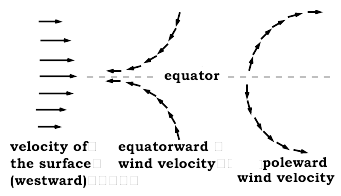|
(S-1B) Global Climate, Global Wind Flow
|
The level where this happens is the beginning of a dry and stable atmospheric layer known as the stratosphere. The part of the atmosphere below that-- the region where weather takes place, more active and more humid--is called the troposphere, and the boundary between it and the stratosphere is the tropopause Large-scale air flows near the equator As heat diffuses through the layers of the atmosphere, it is also spread by atmospheric flows, by winds. In general
|
|
--All air flows are powered by the heat energy given to the ground by the Sun. --Air flows try to get rid of this heat as efficiently as possible. --In general, heated air flows away from where it is heated to where it can best send its heat back to space. |
Timeline Glossary Back to the Master List
Author and Curator: Dr. David P. Stern
Mail to Dr.Stern: stargaze("at" symbol)phy6.org .
Updated 18 March 2012 ; Edited 16 October 2016



